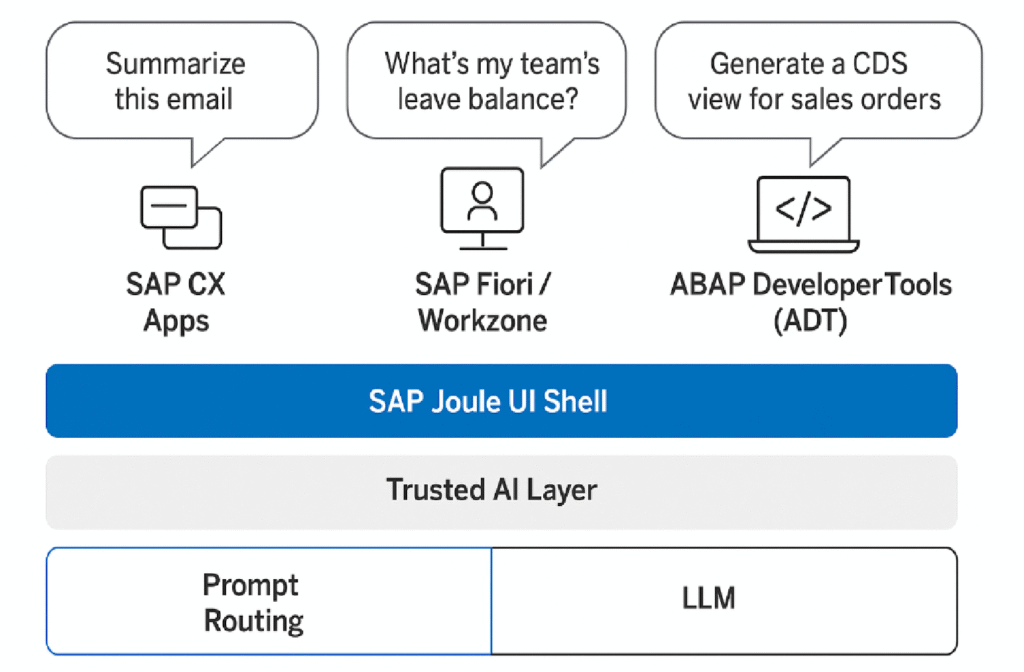As part of my hands-on research into SAP’s AI landscape, I recently explored one of SAP’s most talked-about innovations: SAP Joule. You may have seen it show up in a few places, like Sales Cloud, Fiori apps, or even ABAP Developer Tools. That’s where my confusion began — and why I decided to write this post.
Is SAP Joule a tool? A model? An interface? What is it really — and where is SAP going with it?
Let me walk you through what I’ve learned.
My Initial Confusion: Where Does SAP Joule Live?
So far, I’ve seen SAP Joule appear in three different parts of the SAP ecosystem:
- SAP CX AI Toolkit – In SAP Sales, Service, and Commerce Cloud, Joule is a productivity assistant. It helps generate customer email replies, summarize tickets, or create product content.
- SAP Fiori / Workzone – In the Fiori shell and SAP Workzone, Joule acts like a digital assistant for enterprise users. Ask things like “What’s my team’s PTO balance?” or “Summarize top supplier issues.”
- SAP ABAP Developer Tools (ADT) – For developers, Joule appears in the ABAP programming environment, suggesting CDS views, generating class templates, and explaining syntax.
At first, this made me think: Are these three different Joules? The answer is no.
What SAP Joule Really Is

SAP Joule is not a tool or a model. It’s a conversational AI layer — a smart interface that sits on top of various SAP systems. Its job is to:
- Understand what the user wants using natural language
- Pull relevant business context from SAP systems
- Route the request through a secure SAP AI backend
- Return a helpful result, directly in the user’s workspace
In other words: Joule is like your SAP AI copilot, showing up wherever you work — be it in Sales, Fiori, or ABAP — and always aiming to assist based on your role.
So, What LLM Powers SAP Joule?
Now here’s the interesting part: SAP Joule itself is not an LLM (Large Language Model). Instead, it uses LLMs behind the scenes.
It routes your questions through the SAP Trusted AI Layer, which:
- Protects your data (e.g., masks PII)
- Grounds the prompt with business context
- Sends it to a hosted LLM, like:
- SAP’s internal language model (for common tasks)
- Or external models (like GPT-4 via Microsoft Azure), if configured
So, when you ask Joule something, it’s really passing that request to an LLM — but with SAP’s compliance and business logic layered on top.
Looking Ahead: The Future of SAP Joule
SAP’s long-term direction is clear: Joule will become the central AI assistant for all SAP users.
In the future, it will likely:
- Be tightly integrated with the upcoming SAP Foundation LLM
- Serve as the unified interface to access AI across all modules
- Become smarter, more contextual, and proactive
Think of Joule as evolving into a personal SAP AI agent, one that understands your workflows, knows your data, and speaks your language — whether you’re in sales, development, or operations.
Final Thoughts
I started with a simple question — what is SAP Joule? — and found myself uncovering a much broader architectural shift in how SAP brings AI to users. Joule is not a chatbot, not an LLM, and not tied to one product. It’s a strategic conversational AI layer that’s going to be everywhere in the SAP landscape.
And that’s a good thing.
Let me know your thoughts or corrections if I’ve missed something. We’re all learning this new world of Generative AI together.

